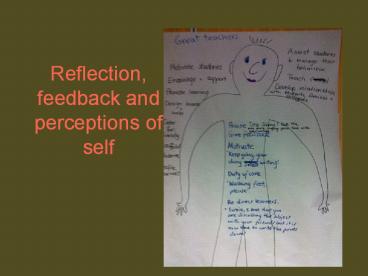Reflection, feedback and perceptions of self - PowerPoint PPT Presentation
1 / 23
Title: Reflection, feedback and perceptions of self
1
Reflection, feedback and perceptions of self
2
Personal totems
3
Revisiting images
- Ideal Teacher
- Me
4
ILP Prep Reviewing your progress
- Demonstrating insight to see things as they
are to accurately perceive the nature of
something - Reviewing the feedback and assessing your
progress - Reflecting on feedback and using it actively to
feed forward
5
Self concept
- What is it?
- How does it work?
- How does it impact on how you read feedback?
6
In Pairs
- List your five most important characteristics
from your perspective - List the five most important characteristics you
have noted about the other person - Share your personal list for yourself with the
other person - Listen to what they said about you (do that for
each other) - What is similar/what is different?
- Did you list things to project a particular image
of yourself or a particular values orientation?
How well do you know each other? How would it
vary?
7
You need to step outside yourself and use the
other to see yourself
8
How cybernetic are you?
- cyber came from a Greek work which meant to
steer or navigate. It came into common use in
the 1940s in relation to the field of
cybernetics and Norbert Wieners concept of
goal-directed systems (Weiner, 1948/1965) - A significant focus of this work was the notion
of feedback loops. - system gt goal gt inputs gt resulting actionsgt
feedback loop gt response to maintain goal gt
controlled by governor - Effective cybernetic systems receive feedback and
respond appropriately to ensure the goal is
reached.
9
Cybernetic systems need positive and negative
feedback to reach equilibrium!
10
Can you identify three pieces of feedback youve
received?
- Feedback you blocked
- Feedback you accepted
- Feedback you accepted and extended upon
- Does it matter who the feedback came from? Who
do you listen to most?
11
1. Action
2. Feedback or response
Subject
Other subjects
3. Response to feedback (intramental and
intermental) 4. Action
12
Cybernetics of self (Identity is a cognitive
tool)
External utterances expressions - Actions,
speech, objects from subject
Subject Ideas concepts and skills, emotions
success and crisis memory accumulated experience
Feedback negative (blocked or rejected)
Feedback critical but from trusted other
(considered and adapted)
Impact of feedback gt Internal dialogue,
internalisation transformation
Identity membrane permeability dependent on
external environment and internal state
Feedback positive (accepted)
Feedback negative (accepted and internalised)
13
Individual subject activity within communal
activity
Feedback
Subject Identity
Personal goal (lead activity) Varying degree of
buy in to the Communal goal
Personal outcome Collective outcome and products
Accept
Reject or accept
Output
Stop, resist, block, adapt, reinforce, extend
Community
14
Activity gt contradiction gt expansive learning
(Engestrom)
15
So
- What is your perception of yourself as a teacher?
- What different kinds of feedback have you/do you
receive? - How do you respond?
- How can you use negative feedback to lead to
expansive learning? - Next step action? What is within your control?
16
Reflection what is a reflection?
- An experience
- Spontaneous interpretation of the experience
- Naming the problem or question that arises
- Generating possible explanations
- Ramifying the explanations into hypotheses
- Experimenting or testing the selected hypothesis
17
Individual Learning Plan
- Are you being honest about your strengths and how
they can be capitalised on? What is the
evidence? - Are you being honest and realistic in identifying
your challenges? What is the evidence? - What is doable and achievable in terms of
strategies and how will you use them to make a
difference?
18
Domain Professional Strengths Professional Challenges Strategies for ILP Review / Comments (End of EPL)
Pedagogy
Networks Partnerships
Professional Knowledge
Futures
19
Domain Professional Strengths Professional Challenges Strategies for ILP Review / Comments (End of EPL)
Pedagogy Strengths in English, SOSE and Visual Arts Building knowledge and confidence in Science and specific topic of Technology in the home with a focus on energy Differentiating learning for different students especially the 2 ASD boy and the 3 students who could be extended Ask Mentor if there are previous resources Visit other year 5 classes/teachers and ask them about strategies theyve used theyve used Do internet research and bookmark good sites Go to school and local library Search QCAR assessment bank Try to find a way to use my visual arts and some other engaging ways to approach Science Design some testing and checking activities that involve group work and individual tasks find ways for ASD students to express ideas orally at times, build in individual extension challenge opportunities.
20
Final reminders
- ILP draft to share with mentor/LLM
- Clarify with mentor what you are responsible for
planning - Work out processes for sharing plans, receiving
feedback responding, sharing reflections etc - Ensure you get oral and written feedback (provide
teacher with templates if needs be) - Use reflection actively you take the initiative
21
Distinction between folios
- Working portfolio - your folder that documents
EPL experiences - Professional portfolio - a folder that
illustrates your progress towards demonstrating
the QCT standards - Folio for EQ teaching positions - a folio that
shows how you meet the EQ selection criteria for
a teaching position
22
Four steps in developing your Professional
Portfolio
- Collecting, categorising and annotating evidence
- Selecting the best evidence
- Reflecting on your selection
- Organising and presenting your portfolio
- Collect examples of planning, reflections,
profiles, assessment tasks, etc that you believe
demonstrate the knowledge and practice indicators
for each standard
23
When in doubt!
- Talk to LLM
- Talk to us! s.davis_at_cqu.edu.au
- Do what youre good at and be good at whatever
you do!































